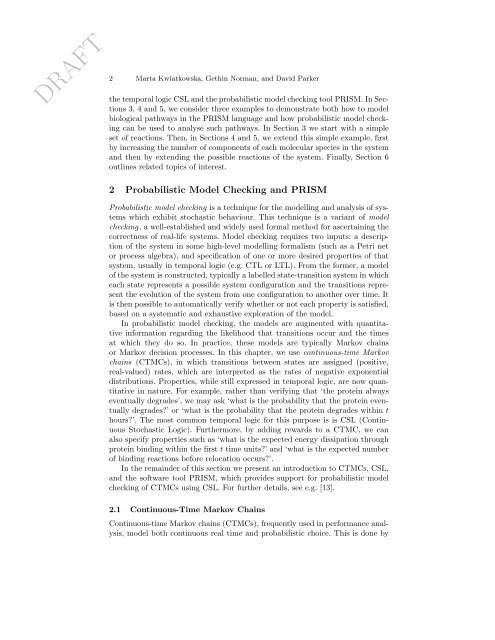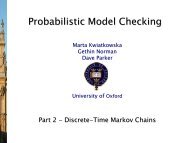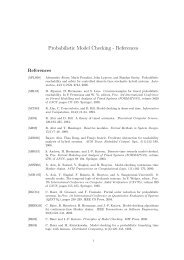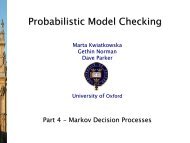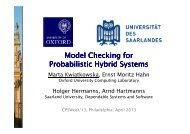Probabilistic Model Checking for Systems Biology - PRISM
Probabilistic Model Checking for Systems Biology - PRISM
Probabilistic Model Checking for Systems Biology - PRISM
You also want an ePaper? Increase the reach of your titles
YUMPU automatically turns print PDFs into web optimized ePapers that Google loves.
DRAFT2 Marta Kwiatkowska, Gethin Norman, and David Parkerthe temporal logic CSL and the probabilistic model checking tool <strong>PRISM</strong>. In Sections3, 4 and 5, we consider three examples to demonstrate both how to modelbiological pathways in the <strong>PRISM</strong> language and how probabilistic model checkingcan be used to analyse such pathways. In Section 3 we start with a simpleset of reactions. Then, in Sections 4 and 5, we extend this simple example, firstby increasing the number of components of each molecular species in the systemand then by extending the possible reactions of the system. Finally, Section 6outlines related topics of interest.2 <strong>Probabilistic</strong> <strong>Model</strong> <strong>Checking</strong> and <strong>PRISM</strong><strong>Probabilistic</strong> model checking is a technique <strong>for</strong> the modelling and analysis of systemswhich exhibit stochastic behaviour. This technique is a variant of modelchecking, a well-established and widely used <strong>for</strong>mal method <strong>for</strong> ascertaining thecorrectness of real-life systems. <strong>Model</strong> checking requires two inputs: a descriptionof the system in some high-level modelling <strong>for</strong>malism (such as a Petri netor process algebra), and specification of one or more desired properties of thatsystem, usually in temporal logic (e.g. CTL or LTL). From the <strong>for</strong>mer, a modelof the system is constructed, typically a labelled state-transition system in whicheach state represents a possible system configuration and the transitions representthe evolution of the system from one configuration to another over time. Itis then possible to automatically verify whether or not each property is satisfied,based on a systematic and exhaustive exploration of the model.In probabilistic model checking, the models are augmented with quantitativein<strong>for</strong>mation regarding the likelihood that transitions occur and the timesat which they do so. In practice, these models are typically Markov chainsor Markov decision processes. In this chapter, we use continuous-time Markovchains (CTMCs), in which transitions between states are assigned (positive,real-valued) rates, which are interpreted as the rates of negative exponentialdistributions. Properties, while still expressed in temporal logic, are now quantitativein nature. For example, rather than verifying that ‘the protein alwayseventually degrades’, we may ask ‘what is the probability that the protein eventuallydegrades?’ or ‘what is the probability that the protein degrades within thours?’. The most common temporal logic <strong>for</strong> this purpose is is CSL (ContinuousStochastic Logic). Furthermore, by adding rewards to a CTMC, we canalso specify properties such as ‘what is the expected energy dissipation throughprotein binding within the first t time units?’ and ‘what is the expected numberof binding reactions be<strong>for</strong>e relocation occurs?’.In the remainder of this section we present an introduction to CTMCs, CSL,and the software tool <strong>PRISM</strong>, which provides support <strong>for</strong> probabilistic modelchecking of CTMCs using CSL. For further details, see e.g. [13].2.1 Continuous-Time Markov ChainsContinuous-time Markov chains (CTMCs), frequently used in per<strong>for</strong>mance analysis,model both continuous real time and probabilistic choice. This is done by


